10.3 Proposals
A great idea does not usually go straight from ideation to implementation. You may think it would be a great idea to change the design of the network in your department, but before anyone gives you the go ahead for such an expensive and time-consuming project, they will need to know that you have done research to ensure the idea is cost effective and will actually be workable. Lots of tasks must be performed before the idea is approved and put into action. Figure 10.3.1 breaks down the various stages a project might go through, and identifies some of the typical communication tasks that might be required at each stage.
The Life Cycle of a Project Idea
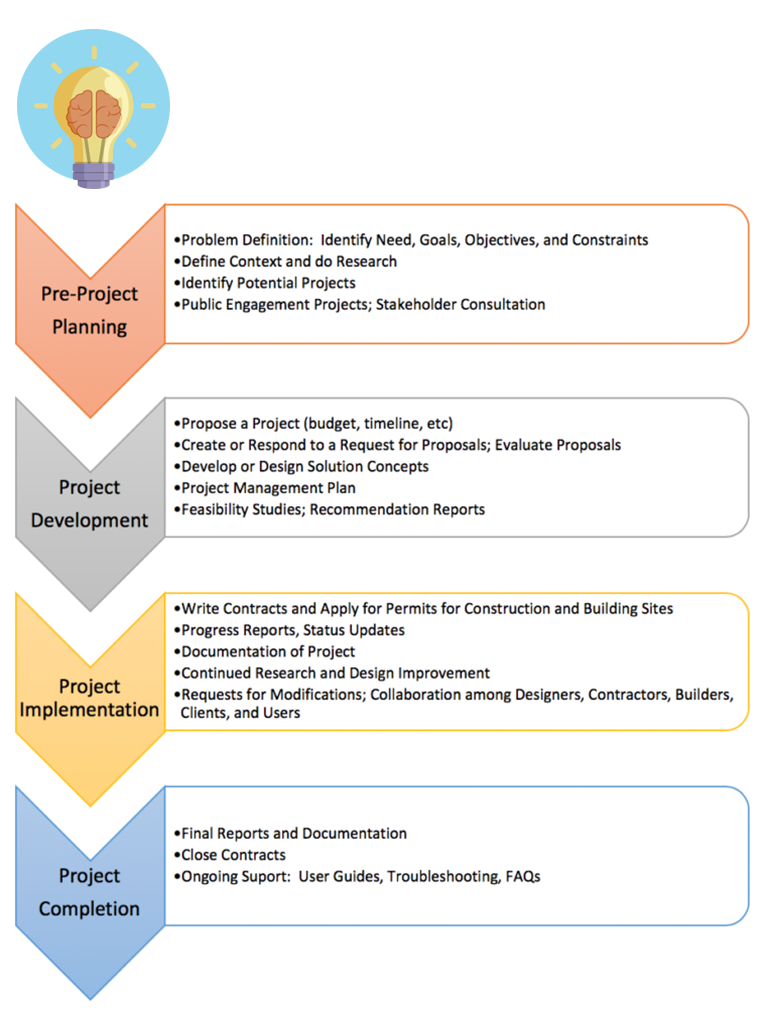
As shown, most ideas start out with a good understanding of a problem or challenge which can possible be resolved with ideas offered in a proposal. So before you propose the new network design, you would study whether or not it is a feasible idea (sometimes using a feasibility report), then proceed to develop the project in your proposal. At the university or college levels, proposals also often take the form of a proposed study to find out if your project idea is reasonable. Your proposal assumes the idea is worth looking into, convinces the reader that it is worth spending the time and resources to proceed, and gives detailed information on how you propose to take action.
Knowledge Check
Proposals

Proposals are some of the most common types of reports in the workplace. Variants of proposals include compliance projects and implementation plans. Proposals are persuasive documents intended to initiate a project often in response to a challenge with the aim of having the reader authorize the course of action proposed in the document. Proposals may be in the form of an informal, short document, addressing a localized need or challenge in your workplace like improving energy efficiency, or the proposal may be a more formal and lengthy document that responds to a request for proposals (RFP) for a complex and costly project like developing software for handheld devices for emergency responders.
A proposal, in the technical sense, is a document that tries to persuade the reader to implement a proposed plan or approve a proposed project. Most companies and organizations rely on effective proposal writing to compete successfully for new contracts. With an effective proposal, the writer convinces the reader that
- the proposed plan or project is worth doing (worth the time, energy and expense necessary to implement),
- the author is the best candidate for implementing the idea,
- the proposed plan is realistic and feasible, and
- that the proposed course of action will result in intangible benefits.
Proposals are persuasive documents intended to initiate a project often in response to a challenge and get the reader to authorize a course of action proposed in the document. These might include proposals to
- perform a task (such as a feasibility study, a research project, etc.)
- provide a product
- provide a service
Proposals are often written in response to a Request For Proposals (RFP) issued by a government agency, organization, or company. The requesting body receives multiple proposals responding to their request, reviews the submitted proposals, and chooses the best one(s) to go forward. Thus, your proposal must persuade the reader that your idea is the one most worth pursuing.
Proposals can have various purposes and thus take many forms; they are usually adapted to the situation at hand. They may include sections such as the following:
- Introduction and/or background
- Problem statement
- Purpose/motivation/goal/objectives
- Definition of scope and approach
- Review of the state of the art
- Technical background
- Project description
- Schedule of work/timeline
- Budget
- Qualifications
- Conclusion
Figure 10.3.3 presents the general outline for proposals irrespective of purpose.
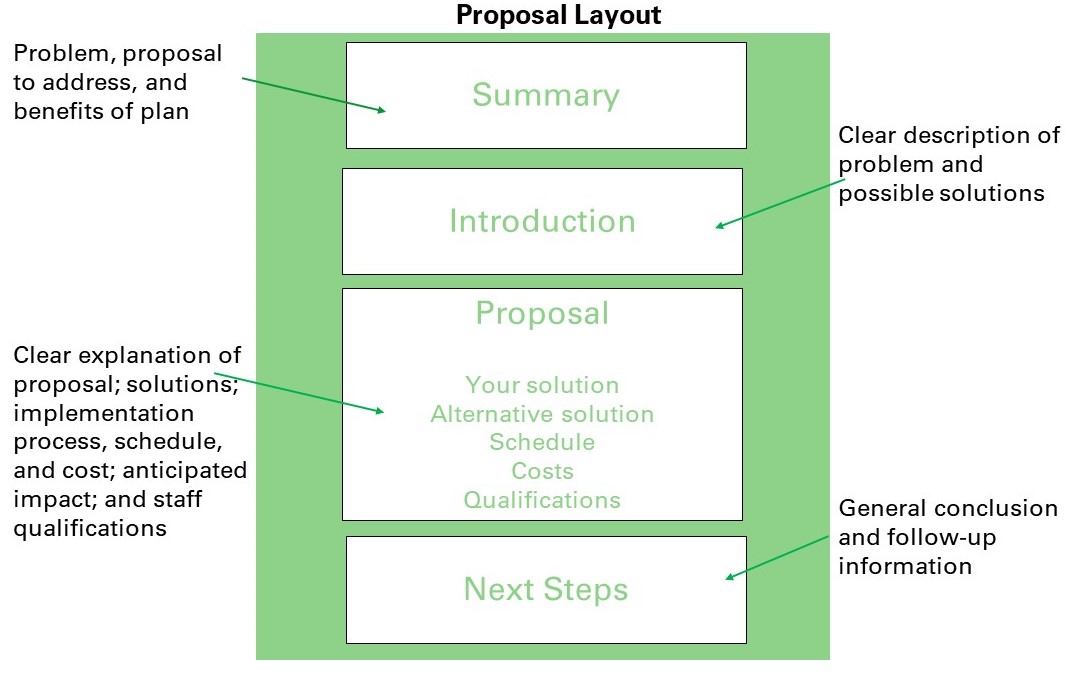
Four Kinds of Proposals
(Types of Business Proposals, n.d.)
As the video suggests and to sum up, four types of proposals are generally standard within organizations:
- Solicited Proposals: An organization identifies a situation or problem that it wants to improve or solve and issues an RFP asking for proposals on how to address it. The requesting organization will vet proposals and choose the most convincing one, often using a detailed scoring rubric or weighted objectives chart to determine which proposal best responds to the request.
- Unsolicited Proposals: A writer perceives a problem or an opportunity and takes the initiative to propose a way to solve the problem or take advantage of the opportunity (without being requested to do so). This can often be the most difficult kind of proposal to get approved and so should include a persuasive rationale for the proposed course of action.
- Internal Proposals: These are written for someone within the same organization as the writers. Since both the writer and reader share the same workplace context, these proposals are generally shorter than external proposals and in technical contexts usually address an isolated issue. As internal documents, they are often sent as memo reports, or introduced with a memo transmittal document if the proposal is lengthy.
- External Proposals: These are sent outside of the writer’s organization to a separate entity (usually to solicit business). Since these are external documents, they are usually sent as a formal report (if long) and introduced by a letter of transmittal. External proposals are usually sent in response to a Request for Proposals, but not always.
Knowledge Check
EXERCISE 10.3.1 Task Analysis
Identify the kinds of proposals you would be likely to write within the industry you will be joining upon graduation. Place them within the grid below. Given the kinds of proposals you would write, what forms would you use (memo report, letter report, or formal report)?
| Solicited | Unsolicited | |
| Internal
|
||
| External |
Key Elements of Proposals
A proposal designed to affect readers’ opinions about public policies and regulations differs from one that proposes to integrate new equipment into a manufacturing process. Accordingly, the following analysis of key elements is presented as a series of considerations as opposed to a comprehensive blueprint. Always adapt your proposal to the context, audience, and purpose. First, view this video for an overview of how to create a proposal:
(How to write a Business Proposal in 10 Easy Steps, n.d.)
Define the Problem(s)
Identify the problem that needs to be solved or the opportunity that could be seized. You must show that you clearly understand the problem/situation if you are to convince the reader that you can solve it. Endeavour to answer questions like the following that your audience is likely to ask:
-
-
- Do I see an understanding of the problem and its implications on our company and people?
- Have the proponents (writers) done relevant research to learn about the complexities of the issue?
- Is the research current, unbiased, and inclusive?
-
In order to answer these questions, provide specifics including statistics, quotes from authorities, results from past research, interviews, and questionnaires.
You can ask an LLM to assist in defining a problem after you have done some investigation to collect context-specific information and determinants. LLM output would not be very useful otherwise. Be sure that you abide by privacy and confidentiality obligations.
Asking an LLM to Assist in Analyzing a Challenge or Problem
Prompt
I am preparing a proposal on the subject of [state the subject]. My purpose is to convince the reader that [state your purpose]. My audience is [describe your primary and secondary audience, if applicable]. My research into the defining problem so far has led me to develop the following conclusions [state 3-4 items], which lead me to believe that [state the proposed course of action] will be the best for this situation.
At this point, I need to draft a clear and informed definition of the problem. So far, I have come up with this description of the issue [paste into the context window or upload your brainstorming]. Begin by asking me what other non-confidential information you need from me to help me create a complete though concise problem statement.
The LLM would then proceed to assist. Throughout the process, continue to collaborate with the LLM using questions and answers until you have a problem statement that reflects the situation and offers specific detail. At some point, you will realize that the LLM’s capabilities are limited because it does not have all the contextual and nuanced information that only you will have. That would be the time to disengage from the LLM to proceed with revisions and supplementation on your own.
Define Your Project Method(s)
How will you gather information (secondary research or primary research)? In the humanities, writers do not explicitly mention their methods; whereas, in business, sciences, technology, and social sciences writers often explicitly mention their methods. For example, if you are proposing to conduct research, your readers will want information regarding how you propose to conduct the research. Will your research involve Internet and library research? Will you interview authorities or conduct a survey? If you are proposing a service, readers will want know how those services will best serve their needs. Often in technical contexts, research will involve surveys, interviews, or charettes and other forms of data collection. Be transparent about how you will go about collecting your information.
LLMs can help you to refine your methods section. Once you have drafted the description, ask the LLM to help you revise the contents so that it is complete. By modifying the above prompt, you can ask the LLM to guide you in developing additional relevant methods or sources of evidenced.
Present Your Solution(s)
Indicate how your proposed solution will solve the problem and provide tangible benefits. Specifically, indicate how it will meet the objectives and abide by the constraints outlined in the problem definition. Give specific examples. Show the specific differences between “how things are now” and “how they could be.” Be as empirical as possible, but appeal to all appropriate persuasive strategies. Emphasize the results, benefits, and feasibility of your proposed idea.
Successful proposals are not vague about proposed solutions. Instead, they tend to outline step-by-step activities and objectives, perhaps even associating particular activities and objectives with dollar figures–if funds are sought to conduct the proposal.
Critical readers are likely to view proposals skeptically, preferring inaction (which doesn’t cost anything) to action (which may involve risk), so your proposed course of action must be well defined and specific. As they review the solutions you propose, they may ask the following three questions:
-
-
- Is the solution feasible and realistic?
- How much time will it take to complete the project?
- Will other factors resolve the problem over time? In other words, is the problem urgent?
- What will it cost to implement, and what will the financial gains be over time?
-
LLMs can assist you in refining your proposed solution(s).
Asking an LLM to Assist in Developing Solutions
Prompt
I am preparing a proposal on the subject of [state the subject]. My purpose is to convince the reader that [state your purpose]. My audience is [describe your primary and secondary audience, if applicable]. My research into the defining problem so far has led me to develop the following conclusions [state 3-4 items], which lead me to believe that [state the proposed course of action] will be the best for this situation.
At this point, I need to draft a specific proposed solution. So far, I have come up with this description [paste into the context window or upload your brainstorming]. Begin by asking me what other non-confidential information you need from me to help me create a complete description of the solution.
The LLM would then proceed to assist. Throughout the process, continue to collaborate with the LLM using questions and answers until you have a described solution that meets the moment. At some point, you will realize that the LLM’s capabilities are limited because it does not have all the contextual and nuanced information that only you will have. That would be the time to disengage from the LLM to proceed with revisions and supplementation on your own.
Show That You Are Organized
Include the practical details: Propose a budget and a timeline for completing your project. Represent these graphically (budget table, and Gantt chart). Your timeline should include the major milestones or deliverables for the project, as well as dates or time frames for the completion of each step.
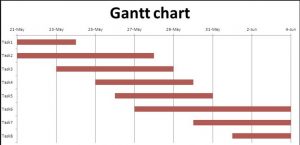
Inspire Confidence in You and Your Team
The persona you project as the author of a proposal plays a fundamental role in the overall success of your project. This persona is infused throughout your document through the tone of language, informed content, and depth of understanding. Your opening sentences generally establish the tone of your text and present to the reader a sense of your persona as a professional and technical expert, both of which play a tremendous role in the overall persuasiveness of your argument. By evaluating how you define the problem, consider counterarguments, or marshal support for your claims, your readers will make inferences about your character and abilities.
To establish credibility, ensure that your approach is balanced, unbiased, inclusive, and fair. Once you have drafted your document, you can ask an LLM to review it and provide feedback on these characteristics. You can also ask it to “play the devil’s advocate” to raise potential arguments against your proposed approach. Doing so will help you formulate strong arguments to explain how your approach is feasible and cost-effective. Of course, honesty is important: avoid fudging the details. Honesty will go a long way to reinforcing the value of your proposal.
Asking an LLM to Play the Devil’s Advocate
Prompt
I am preparing a proposal on the subject of [state the subject]. My purpose is to convince the reader that [state your purpose]. My audience is [describe your primary and secondary audience, if applicable]. My research into the defining problem so far has led me to develop the following conclusions [state 3-4 items], which lead me to believe that [state the proposed course of action] will be the best for this situation. Read the [pasted, attached] draft project proposal.
At this point, I need to account for any potential counter-arguments that may arise to my proposed course of action. I’ve already considered [state those you have considered], but I want counter-arguments to include those made by experts or managers in [state the areas of expertise of potential reviewers]. Begin by asking me what other non-confidential information you need from me to help me to understand my proposal. Next, take on the role of someone who is questioning the proposed action. Use a question and answer approach to guide me through a reasoned process of rethinking my approach from a critical perspective.
The LLM would then proceed to assist. Throughout the process, continue to collaborate with the LLM using questions and answers until you feel that you have a good grasp of the potential objections and counter-arguments to your proposed action. At that point, you will then be able to incorporate into your proposal responses to anticipated resistance.
Key Approaches
Use the following approaches to refine your proposal so that it is specific to the situation at hand and supported with relevant and current evidence, includes concreate and specific detail, and is conveyed using a confident tone.
Tighten the Focus
Proposal writers bring focus to their proposals by highlighting the urgency of the problem and by providing the evidence readers need to believe the proposed solution can work. Having a solid understanding of the opportunity and challenge that forms the basis of the proposal will enable you to address the situation in a manner that is convincing and realistic, so always analyze the circumstances underlying the situation as you plan your work.
You can ask an LLM to review the evidence you have included in the section of the proposal that describes the proposed solution. Modify one of the prompts shown above to make the request for assistance.
Account for Various Stakeholders
Proposals inevitably affect people. The actions taken based on projects that originate from proposals will affect co-workers, management, the organization, and often the broader community. Ensure that your proposal is inclusive by accounting for the needs of various groups including Indigenous, older adults, peoples of color, LGBTQ+, and others as they apply to your proposed project.
Use Concrete Development
It’s true that some proposals are won on appeals to emotion. But ultimately, an argument needs to be based on reason and facts. You need to conduct research to find the facts, opinions, and research that support your proposed course of action or offer. Include context-specific research as well as research into what has been done previously and cutting edge approaches. Investigate what others have done in similar situations and which approaches have worked or have not been so successful. With this knowledge, you can then create your own innovative approach.
Use Confident and Logical Language
Proposals are fundamentally persuasive documents, so paying attention to the rhetorical situation. The position of the reader (upward, lateral, downward or outward communication), the purpose of the proposal, the form, and the tone are paramount. Your task is to use a confident tone to convince the reader that your project is accurate, feasible, realistic, and beneficial to the reader. While employing persuasive writing strategies, it is important to avoid common logical fallacies. To review the principles of persuasive writing, please go to: Chapter 3.4: Writing to Persuade
Generally, the following principles will help you develop a style that is suited for proposals:
- Clearly define your purpose and audience before you begin to write.
- Be sure you have done the research so you know what you are writing about.
- Remain positive and constructive; don’t blame people or dwell on the negative; rather, focus on the path forward.
- Be solution-oriented; you are seeking to improve a situation.
- Make your introduction very logical, objective, and empirical; don’t start off sounding like an advertisement or sounding biased.
- Use primarily logical and ethical appeals; use emotional appeals sparingly.
- As always, adhere to the 7 Cs by making sure that your writing is
- Clear and Coherent: Don’t confuse your reader with unclear ideas or an illogical structure.
- Concise and Courteous: Don’t annoy your reader with clutter, unnecessary padding, inappropriate tone, or hard-to-read formatting.
- Concrete and Complete: Avoid vague generalities; give specifics. Don’t leave out information necessary for decision-making.
- Correct: Don’t undermine your professional credibility by neglecting grammar and spelling or by including inaccurate information.
Once you have drafted your document, you can enlist the assistance of an LLM to review the text to ensure that you meet the above criteria.
Asking an LLM to Review Your Document
Prompt
Read the [uploaded, pasted] proposal, Summarize the proposal.
Once you have established that the LLM has a correct understanding of your document, proceed to ask the LLM to guide you in a review to ensure the document is readable using the prompting strategy provided in Chapter 4.5 Revising for Readability.
Additional Considerations
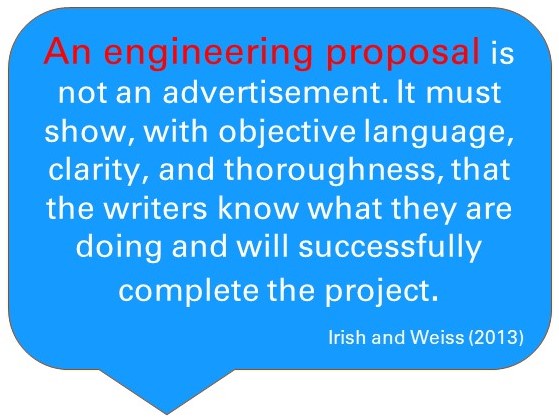 All proposals must be convincing, logical, and credible. They are persuasive documents, so all components must be carefully considered as you integrate them into the document. You should also do the following:
All proposals must be convincing, logical, and credible. They are persuasive documents, so all components must be carefully considered as you integrate them into the document. You should also do the following:
- Describe your qualifications to take on and/or lead this project; persuade the reader that you have the required skills, experience, and expertise to complete this job. For complex and lengthy projects, also introduce key team members and technical leads.
- Include graphics to illustrate your ideas, present data, and enhance your pitch.
- Include secondary research to support your claims and to enhance your credibility and the strength of your proposal.
- Choose the format according to the context; is this a memo report to an internal audience or a formal report to an external audience? Does it require a letter of transmittal?
Proposal Organization: A Sample
Each proposal will be unique in that it must address a particular audience, in a particular context, for a specific purpose. To read sample proposals, visit David McMurrey’s Online Technical Writing # Proposals for examples. However, the following offers a fairly standard organization for many types of proposals:
| Introduction/Background |
Clearly and fully defines the problem or opportunity addressed by the proposal, and briefly presents the solution idea; convinces the reader that there is a clear need, and a clear benefit to the proposed idea.
|
| Project Description |
Detailed description of solution idea and detailed explanation of how the proposed idea will improve the situation:
|
| Qualifications |
Establish the writer’s qualifications and experience to lead this project. |
| Timeline and Budget |
Provide a detailed timeline for completion of project (use a Gantt chart (see Figure 8.2.4) to indicate when each stage of the project will be complete). Provide an itemized budget for completing the proposed project. |
| Conclusion |
This is your last chance to convince the reader; be persuasive! And ask for authorization to proceed. |
| References |
List your research sources. |
Knowledge Check
Sample Informal/Short Proposal
Here below in Figure 10.3.5 is a sample short research proposal formatted as a memo report.
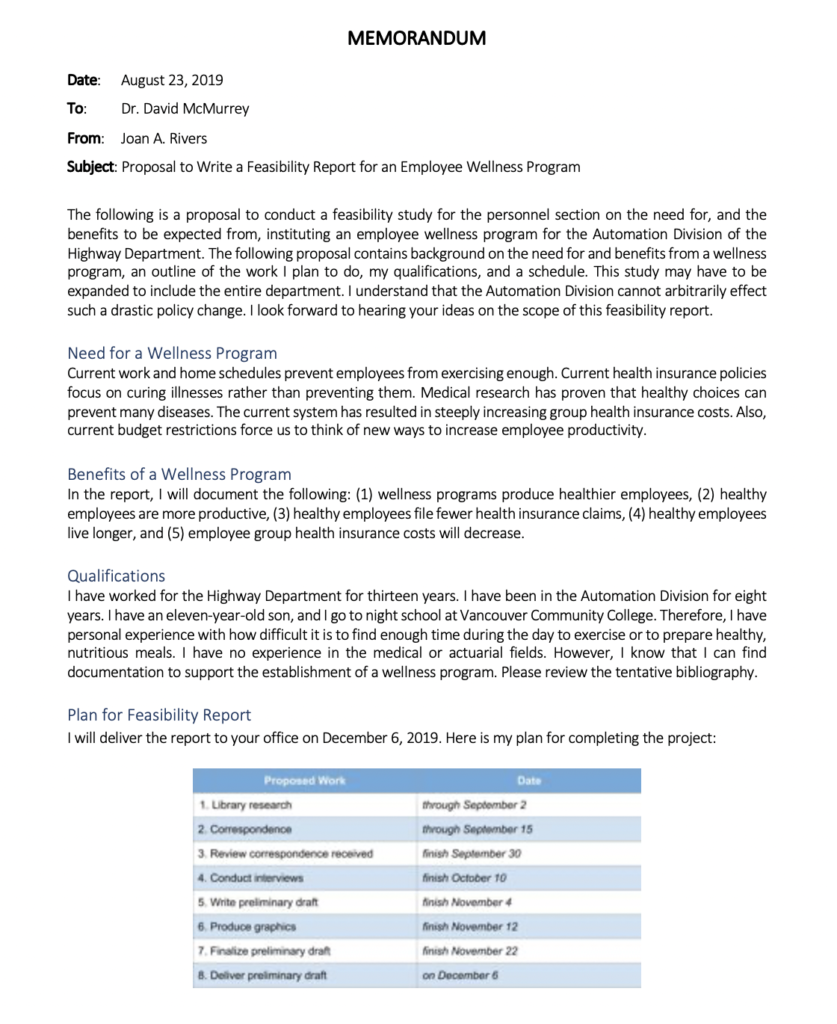
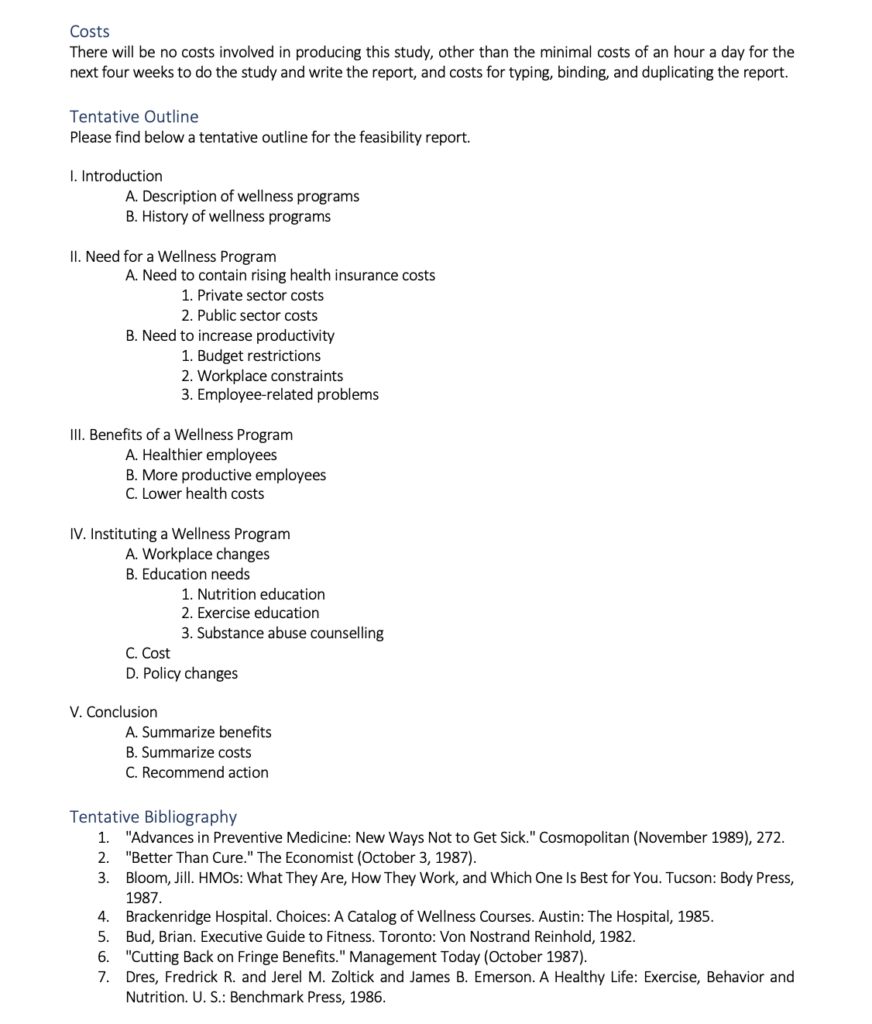
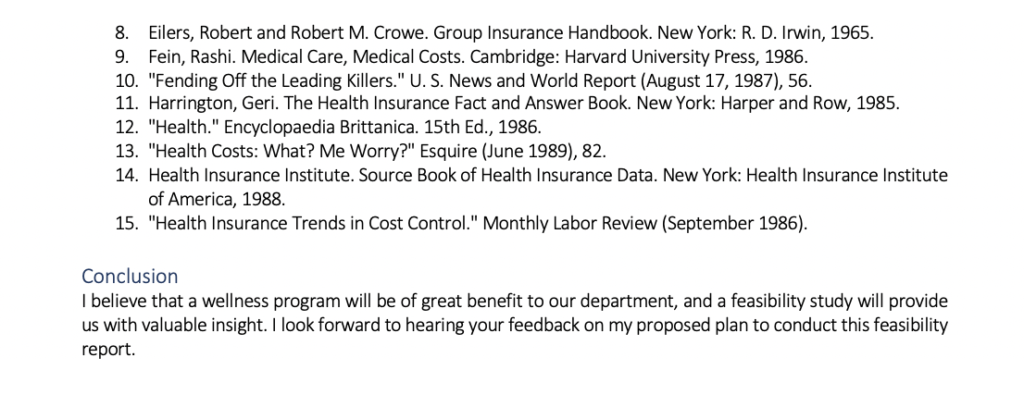
Figure 10.3.5 Letter Proposal–adapted by Venecia Williams (2020) from Example Proposal 1 by David McMurrey (1997-2017).
Why Project Proposals Might be Rejected
A proposal or recommendation needs research to convince the reader that the idea is worth pursuing or implementing. A project proposal could be rejected for any of the following reasons related to insufficient research:
Unclear Problem: The research problem is not clearly defined, so the research plan has no clear focus (your ideas are too vague and not well thought out)
Unnecessary Project: This issue is already well-known or the problem has already been solved (or is in the process of being solved). For example, proposing that the school cafeteria should replace plastic cutlery with compostable cutlery, when it has already done so, would result in a rejected proposal.
Impractical Scope: Access to information, resources, and equipment needed to complete your proposed study may not be available; adequate conclusions cannot be reached in the designated time frame and with resources available. For example, if you propose to do a study that will take two years, but your project is due in two months, the proposal will be rejected.
Be sure to submit your proposal to a thorough review before sending it to the procurer.
References
Ewald, T. (2017). Writing in the technical fields: A practical guide (2nd ed.). Oxford University Press.
Greeg, U. (n.d.). Types of business proposals [Video]. Youtube. https://www.youtube.com/watch?v=mTSah0Sf_fU
[Lightbulb image]. https://www.iconfinder.com/icons/667355/aha_brilliance_idea_think_thought_icon. Free for commercial use.
Mackenzi Investment. (2021, September 23).Mackenzie Investments Retirement Study: Canadians are saving for retirement, but majority lack confidence on how to manage their nest egg. https://www.mackenzieinvestments.com/en/media-centre/press-releases/_2021/2021-september-23-mackenzie-investments-retirement-study-canadians-are-saving-retirement
McMurrey, D. (1997-2017). Examples, cases, and models. Online technical writing. https://mcmassociates.io/textbook/models.html
Moxley, J. (2009/2012/2018). Proposals. In Professional and technical communication (2019). OER. Suzie Baker, Adapter. https://www.oercommons.org/authoring/54645-professional-and-technical-writing/7/view
[Proposal image]. [Online]. Available: https://pixabay.com/en/couple-love-marriage-proposal-47192/. Pixabay License.
Williams, V. (2020). Business proposals. Fundamentals of business communication. OER. https://pressbooks.bccampus.ca/businesswritingessentials/chapter/chapter-13-business-proposals/
SMB Guide. (n.d.). How to write a business proposal [Video]. Youtube. https://www.youtube.com/watch?v=p6kTK6HfS4Y

